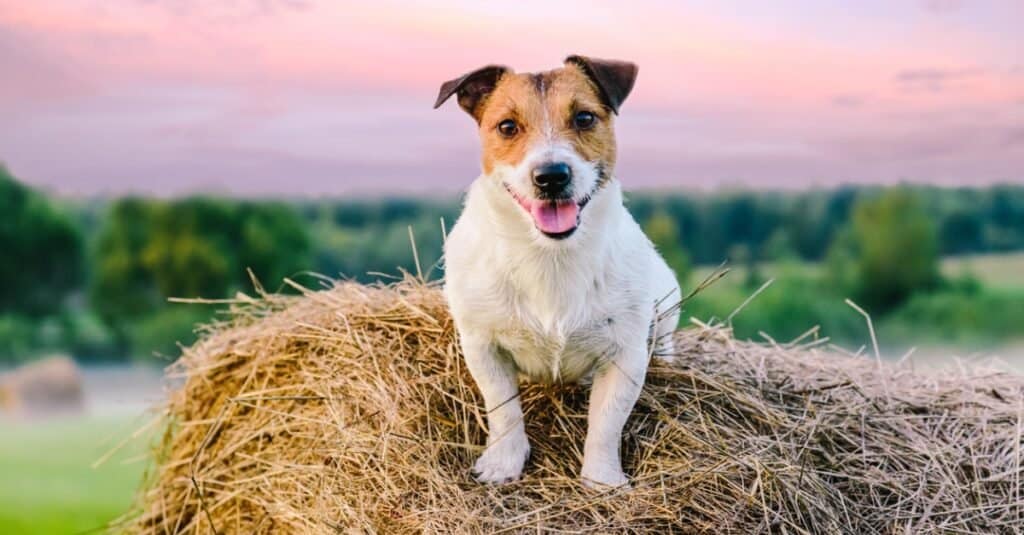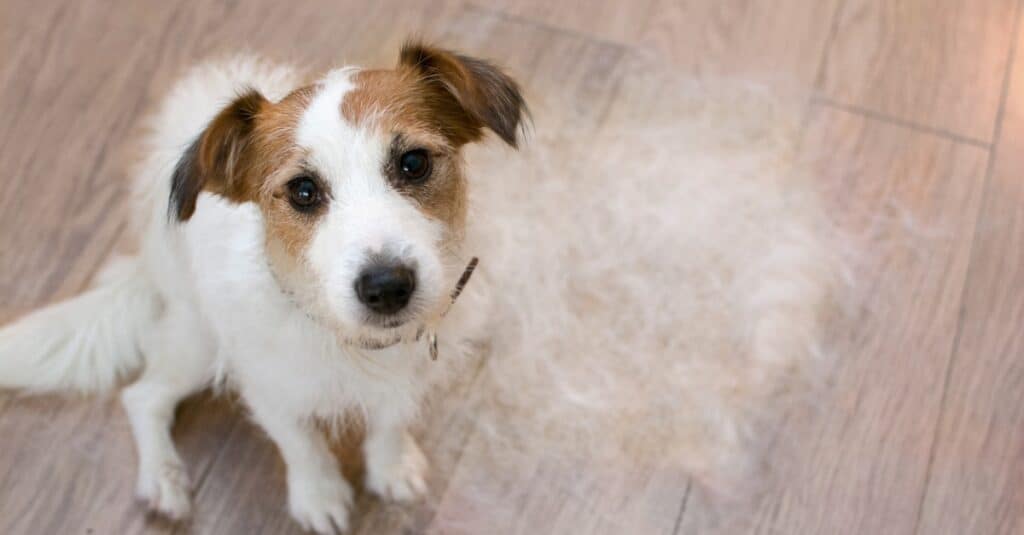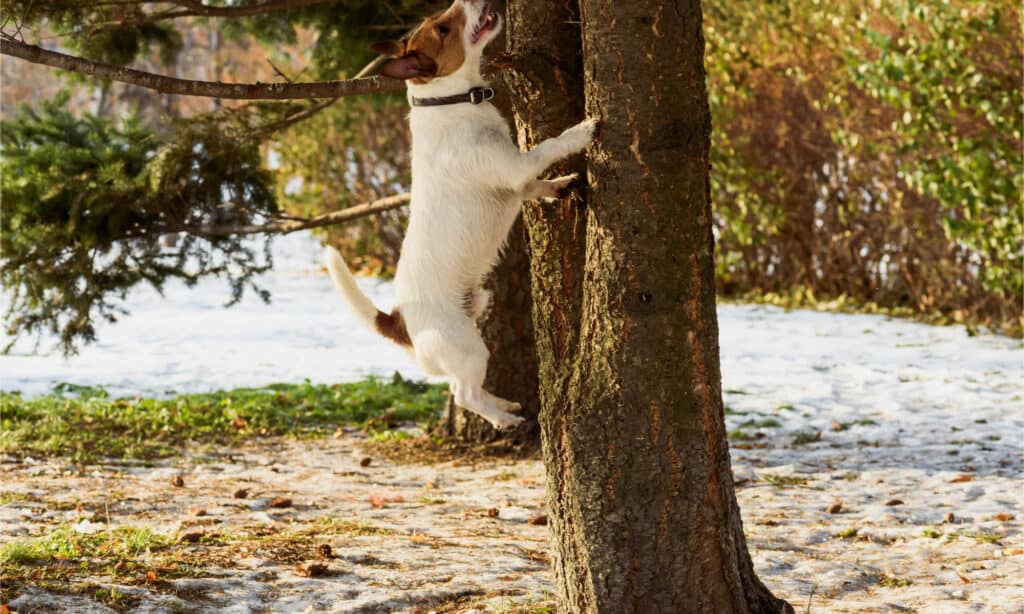Have you just welcomed a Jack Russel terrier puppy into your family? This is an exciting time filled with laughter and love. It’s also the perfect time to learn about your growing Jack Russel pup. We want to help you become the best pup parent possible! In this article we discuss Jack Russel progression, including growth chart, diet tips, and training advice.
Let’s get started!
Jack Russell Terrier Breed History

The Jack
Russell terrier
was originally bred to assist hound dogs with hunting foxes.
©iStock.com/alexei_tm
The beloved Jack Russell terrier was created in England during the 1800’s. Person John Russel wanted to create a dog that could assist hounds on hunts by chasing foxes out of their dens. After the foxes were visible, the hounds would chase them. The breed soon become an essential tool for sportsmen, especially for hunters that rode on horseback.
These dogs were soon brought to the U.S. in the early 1900’s due to their impressive hunting reputation. Though it took some time, the breed finally took their spot on the American Kennel Club’s registry in 2000. The Jack Russel terrier is still bred for hunting and working purposes, but many are treasured family dogs as well.
Jack Russell Terrier: Growth and Weight Chart by Age
Check out the month to month growth chart for the Jack Russell terrier!
| Age | Male & Female Weight |
| Birth | Under 1 pound |
| 1 Month | 2-3 pounds |
| 6 Weeks | 2-4 pounds |
| 2 Months | 4-6 pounds |
| 3 Months | 6-8 pounds |
| 4 Months | 7-10 pounds |
| 5 Months | 8-11 pounds |
| 6 Months | 11-13 pounds |
| 7 Months | 11-14 pounds |
| 8 Months | 12-15 pounds |
| 9 Months | 12-16 pounds |
| 10 Months | 13-17 pounds |
| 11 Months | 13-17 pounds |
| 12 Months | 13-17 pounds |
| 2 Years | 13-18 pounds |
When Will My Jack Russell Terrier Stop Growing & How Big Will He Be When Fully Grown?
The Jack Russell is a small breed dog. They typically reach their mature height around nine months, and their ultimate weight around 11 months. Most Jack Russell terriers will reach 10 to 15 inches in height at the shoulder, and weigh about 13-18 pounds. Adults may fill out around the chest and abdomen after their first year, but this will vary based on lifestyle.
We always suggest seeing your Jack Russell’s parents in person if you would like an accurate idea of mature weight. The parent’s size is the best indicator of how big your little one will be when fully grown.
When Should My Jack Russell Terrier Stop Eating Puppy Food?
Adequate nutrition is key for your Jack Russell puppy as he grows into adulthood. Growing puppies need extra calories per cup, calcium for bone support, and vitamins for healthy brain development. Puppy food contains each of these essential ingredients!
We suggest feeding your growing Jack Russel a puppy diet until 10 months of age. Once he is 10 months old, you can transition him to an adult diet created for small breed dogs. Just make sure you transition him over a two-week period, as switching a diet abruptly often leads to GI upset.
When Will My Jack Russell Terrier Start Losing Teeth?
Did you just find one of your Jack Russell’s puppy teeth? This is completely normal, but let’s break down the teething process so you know what to expect!
Most puppies begin to grow puppy teeth at around three weeks. They should have a full set of puppy teeth by six weeks. These puppy teeth will hang around until they are three months old. At this point, they will start to lose these puppy teeth until they are six months old. By the time they are seven months old, they should have a full set of adult teeth.
If your Jack Russell terrier is teething, then we suggest making sure he has plenty of chew toys!
When Should I Start Training My Jack Russell Terrier?

The Jack Russell terrier is typically easy to train due to their intelligence level.
©iStock.com/smrm1977
The Jack Russell terrier typically catches on quickly to obedience training due to their fierce intelligence and interest in learning. However, with this intelligence comes stubbornness. It’s important to implement obedience training from the moment you adopt your Jack Russell puppy. If you establish your expectations early on, the Jack Russell will be less likely to participate in stubborn behavior.
What Commands Should I Teach My Jack Russell Terrier First?
Once you are ready to dive into training, you may wonder which commands you should start with first. Let’s list the cues we think all puppies should learn, along with a few other training tips!
- Sit
- Lay down
- Stay
- Come
- Drop it
The Jack Russell terrier was bred to hunt foxes and other small animals. For this reason, their prey drive is often very high. This means that your terrier may chase cats and other small animals. It’s important to be aware of this possibility if you have a feline family member.
While chasing is natural for the Jack Russell, socialization can help limit this behavior. If you have cats or other small animals, then we suggest introducing your pup to them during puppyhood. Monitor your Jack Russell when he first meets your beloved cat, as you want to make sure everyone is safe.
Jack Russell terriers are known to struggle with aggression towards other canine friends. Introducing them to other dogs is essential in the socialization process. Just be sure he is fully vaccinated before doing so. You do not want him exposed to infectious illnesses from unknown pups.
When Should My Jack Russell Terrier Be House Broken?
The Jack Russell terrier catches on to obedience training quickly, and potty training is no different! The potty-training process is often a breeze for Jack Russel terrier parents. Simply offer consistent and positive training each step of the way. Most Jack Russel terrier puppies will be potty trained by the time they are six months old, or within three months of their potty training being implemented.
When Should My Jack Russell Terrier Be Spayed or Neutered?

The best time to spay or neuter your Jack Russell is between the ages of six months to one year.
©Javier Brosch/Shutterstock.com
If you are not interested in breeding your Jack Russell terrier, then it is important to be aware of the best age range to spay or neuter your canine friend. Spaying or neutering can lower a pup’s risk of developing reproductive cancers, eliminate the potential for reproductive infections, and even cut down on hormonally driven behaviors like marking or escape attempts.
According to most veterinarians, the best time to spay or neuter your Jack Russel terrier is between the ages of six months to one year. This time frame is early enough to decrease the potential of undesirable behaviors, while late enough to maintain a safe surgical process. However, your veterinarian knows what’s best for your pup, so always reach out to your veterinary team for guidance.
Common Health Issues in the Jack Russell Terrier
Most Jack Russel terriers will live a long and healthy life between 10 to 15 years, but there are a few health complications they are prone to experiencing. It’s always best to keep an eye out for the conditions listed below.
Patellar Luxation: This occurs due to the misalignment of the knee joint, which leads to instability in the dog’s kneecap, allowing the kneecap to move out of its normal place during activity. Not only is this uncomfortable, but it can lead to significant arthritis in the knee joint over time. A Jack Russell terrier with a luxating patella may experience occasional limping, skipping when running, leg sensitivity, and stiffness in the affected limb. Severe cases may require surgery.
Glaucoma: This painful eye condition develops when the pressure in the eye grows abnormally high. When natural fluid within the dog’s eye is unable to drain normally, it builds up in the eye. This is not only incredibly painful, but it can lead to blindness if it is not treated quickly. Common symptoms of glaucoma include eye redness, watery eyes, pawing at the eyes, swelling of the eye, frequent squinting, and light sensitivity.
Lens Luxation: This occurs when the lens of the eye is displaced from the ligament holding it in place. This occurs due to deterioration to the ligament itself, and it often requires surgery to repair. Common signs of lens luxation include eye squinting, pawing at the eye, eye redness, changes in eye appearance, and facial sensitivity.
Most of these conditions can be managed when they are caught early, so we always suggest having your pup assessed by a vet if he develops any of the symptoms we mentioned above. This will offer your pup the best chance at a smooth recovery.
Pictures of Jack Russel Terrier Puppies

The Jack Russell terrier is known to be highly energetic and playful.
©OlesyaNickolaeva/Shutterstock.com
Pictures of the Jack Russell Terrier At 6 Months

Jack Russell terriers can be a bit stubborn, so it’s important to be consistent with your training.
©Ramonki/Shutterstock.com
Pictures of Fully Grown Jack Russell Terriers

Jack Russell terriers love to chase squirrels!
©alexei_tm/Shutterstock.com

These energetic terriers can run up to 38 miles per hour.
©BIGANDT.COM/Shutterstock.com

Jack Russell terriers love to spend time outdoors with those they love.
©iStock.com/alexei_tm
The photo featured at the top of this post is © iStock.com/alexei_tm
Ready to discover the top 10 cutest dog breeds in the entire world?
How about the fastest dogs, the largest dogs and those that are -- quite frankly -- just the kindest dogs on the planet? Each day, AZ Animals sends out lists just like this to our thousands of email subscribers. And the best part? It's FREE. Join today by entering your email below.
Thank you for reading! Have some feedback for us? Contact the AZ Animals editorial team.






